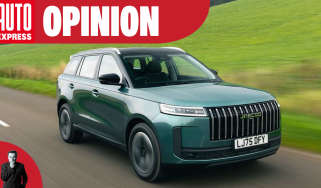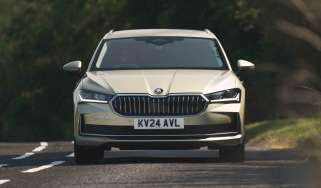How we test cars: why you can trust Auto Express car reviews
Find the expert verdicts you can trust on every new and used car with Auto Express car reviews
Auto Express has been keeping car buyers and car fans alike up to speed with the automotive world ever since it launched in 1988. A big part of informing and educating our readers comes through our rigorous car road test and review process that’s been going since day one - indeed our first ever issue contained a three-way group test with a Vauxhall Cavalier, Ford Sierra and a Peugeot 405.
With ever changing cars, a bigger market and more complex technologies to assess, our testing process has become ever more thorough. At the last count, the members of the Auto Express Road test team cover 350,000 miles a year, every year, testing the latest cars in locations around the world.
The best way to establish which cars deserve their status as class-leaders, and which ones are not up to scratch, is by directly comparing them head-to-head with their most capable competition. So whether it’s a pair, a trio or more, we regularly collect all the big hitters for in-depth group tests on UK roads, a level playing field that gets under the skin of each car.
These group test findings supplement our in-depth single car reviews where we test and analyse specific models in detail and regularly update with the latest findings as model ranges change and more versions are driven in different road conditions.
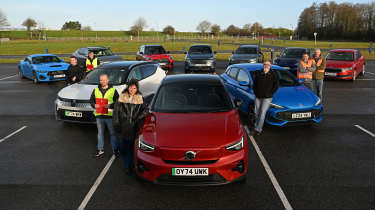
How we test cars
Our reviews cover six main categories:
Used - available now

2022 MG
HS
17,602 milesAutomaticPetrol1.5L
Cash £16,000
2024 BMW
i4
10,447 milesAutomaticElectric
Cash £36,200
2023 Volkswagen
Arteon
32,422 milesAutomaticPetrol2.0L
Cash £23,700
2022 Nissan
Qashqai
18,356 milesAutomaticPetrol1.3L
Cash £22,650- Engines and performance - Here we look at the powertrains on offer in each model, and rate their performance, refinement and usability.
- Driving - Split into three subcategories, the driving section dives deeply into how a car feels on the road, from its ride to the handling, from its steering to its braking ability.
- Efficiency and running costs - Everyone wants to look after the pennies, so through real-world driving we establish how much every car we test will cost you to run - regardless of fuel type.
- Interior and tech - Whether it’s through funky looks, slick in-car tech or peerless build quality, great cabin design can make or break any car
- Practicality - Style is nothing without substance, and we get the tape measure out to see how every car’s cabin feels both against its rivals and the wider market
- Reliability and safety - We use both safety data from Euro NCAP and our own industry-leading owner satisfaction research to score each car on its everyday usability and dependability.
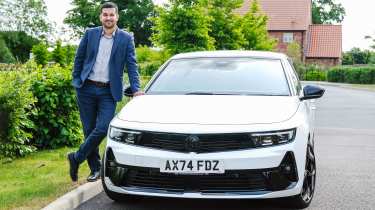
Focus on car buyers
Within each of the categories above, there are many factors that contribute to the overall star-rating score. And then there’s the type of car to consider. Our regular research into what car buyers in different segments of the market really value most in their cars allows us to adjust the focus of our reviews to make them as useful as possible.
For example, we know that a car’s level of agility through a set of twisty turns is less important to the buyer of an MPV than it is a sports car. As such, we’ll provide more detail about the ride and handling characteristics of a performance vehicle. MPV or SUV buyers, on the other hand, value practicality and ease of use, so we’ll focus much more on how easy the seats are to fold, how easy it is to install a child seat, and how much space there is in the boot, with these kinds of vehicle.
Equally, our review scores are always awarded in context of the car’s rivals, the alternative models a buyer may be considering, rather than based on the new car market as a whole.
For example, looking purely at the marks we give, there may be an occasion when a four-seat coupe gets a practicality score that matches or even beats a large SUV. That’s not to say that the SUV isn’t the more spacious car - because it will be - but relative to each cars’ rivals, it means that our hypothetical coupe is performing very well while the SUV is not. For a car buyer considering an SUV, it’s far more useful to know how good it is in context of the other similar cars on their shortlist.
Auto Express car reviews in detail
There’s a lot to think about when reviewing a modern car and the Auto Express review team examine every model tested in great detail. Let’s run through the different in-depth review sections…

Engines and performance
Many cars come with numerous engine choices under the bonnet. Traditionally, this would mean petrol and diesel offerings in a range of sizes and power outputs, but now there are mild hybrid, plug-in hybrid, electric and just occasionally even hydrogen powertrains on offer. We go into detail about each and every variation, using our extensive time behind the wheel of each to recommend which models and engines make the most sense.
We come to this conclusion based on the subjective performance of each option - this doesn’t just mean how fast they are (though that is a factor), but particularly how well calibrated the system is; this means we award marks based on how easy it is to control the throttle, how responsive it is to inputs and, if it’s a hybrid powertrain, how smoothly and quickly the system transitions between petrol and electric modes. Beyond this, the smoothness of the powertrain, and the levels of noise, vibration and harshness all play a key part in the verdict.
Of course, context is important yet again. Someone buying a performance car might enjoy hearing the noise of an engine, and they might even want an engine which needs to be revved to its limiter in order to extract its very best. Buyers of family cars want the complete opposite; something that sounds much more muted and offers smooth, effortless response for driving that’s so eas,y it’s barely given a second thought. We always take these things into account depending on what car we’re testing.

Driving
Beyond the powertrain, there are a range of other factors that contribute to how well a car drives. We separate these areas into three categories:
Around town
Low speed driving is always an important factor in any car. How a car drives in urban areas or general low-speed manoeuvring is hugely important to owners, so we assess the weight of the steering, the tightness of the turning circle, and the all-round visibility to provide a judgement on how easy (or difficult) it’ll be to drive around town. Any tech that might help to make life a little easier - like parking sensors, cameras and autonomous parking systems, are tested and noted here.
Beyond that ease of use, we also note ride comfort at this point. Different cars provide different levels of comfort at varying speeds; cars with larger wheels and low profile tyres can often jiggle and fidget over smaller low-speed bumps, while the quality of the damping and isolation materials between the tyres and the driver have a bearing on how harsh those bumps can feel to driver and passengers as the car crosses them.
A and B roads
On the face of things, delving deep into the handling characteristics of every car on sale might seem unnecessary. After all, buyers of the typical family hatchback or compact SUV are unlikely to be pushing their car to the limits of its grip on regular occasions.
However, it’s still very important to note how all cars behave when pushed to their extremities; in the unlikely event a driver has to perform an emergency manoeuvre or gets caught out by an unexpectedly tight turn on a damp road, it’s very important to know if the car will behave predictably and capably. Grip levels in all conditions are important, and also what happens when that limit of grip arrives.
Of course, this category holds significant influence over our assessment of performance cars - and as such, we'll go into much more detail in this area for hot hatches, performance coupes and supercars. Here, we’ll inform you about the balance of the chassis - how willing it is to be influenced by the driver’s inputs on the throttle or the steering - and how agile (or not) the chassis feels through the corners.
Steering feel and feedback can make or break a car’s driving experience; a good car relays detail through the steering rack, allowing the driver to gauge how much grip is available, lending an extra level of confidence as to how hard the front axle can be pushed.
The suspension and ride also plays a part at this stage. Not only does comfort matter at this point, but the response of the suspension can play a part in a car’s ability to corner. Too soft, and the car might float clumsily from one corner to the next, with excessive body roll affecting how well the car behaves through a turn. Too stiff, and the car will be hard to trust through a corner; the feeling of skipping from one bump to the next can be equally as harmful to making good progress.
There’s a sweet spot in the middle; enough composure that body control remains in check over undulating roads, but sufficient compliance in the suspension to keep the driver and occupants comfortable when the surface becomes harsh.
Motorways
With so few corners to contend with at motorway speeds, the two considerations here are comfort and refinement. In terms of the former, the two things we’re looking for are ride comfort and overall stability - the latter a mix of how planted and reassuring the car feels at speed, and how sensitive the steering is around the straight-ahead.
Refinement is influenced by noise levels, be that noise from the tyres, wind noise, and the sound of the engine. In our comparison tests, we measure relative noise levels of rivals along the same stretch of road and identical speeds to judge which cars are more refined. From there, we make a subjective comment on where one car performs better than the other.
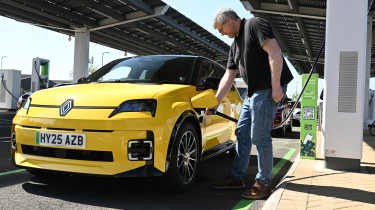
MPG and running costs
Even car buyers with the deepest pockets don’t want to needlessly throw money down the drain, and there’s a few ways that can happen. The one area which will be most obvious to buyers on a daily basis will be fuel consumption or efficiency.
In our reviews, we not only list the official WLTP figures provided by the manufacturer in question, but we also offer our own real world figures, which we acquire through driving on a wide mix of roads - from urban and residential areas, to twisty roads, to longer motorway trips. These figures should give a clearer idea of the kind of efficiency an owner in the UK is likely to achieve with the car.
Based on average UK fuel prices, which we update weekly, we then use our real-world mpg figure to calculate how much cars will cost to run over the course of 10,000 miles.
Of course, there’s also the fundamental price to buy the car in the first place. While a car brand might offer some competitive figures on a price list, it might be easier to find better deals elsewhere - we check the latest deals on our own Buy A Car service which pulls in the best current offers and discounts from dealers around the UK. This gives a clearer view of how much the car will really cost you to buy.
EV Range, battery and charging
Electric cars are still a new and rapidly developing technology, so we provide as much detail as possible to our electric vehicle reports, to let buyers know just how much real-world range to expect.
We’ll note our test efficiency in miles per kilowatt hour (m/kWh, and multiply that figure by the car’s usable battery capacity, to calculate a theoretical range. However, this figure is still no guarantee of an exact figure that buyers can expect.
Our testing covers a varied range of roads, and some conditions are more favourable for range than others. If you drive mostly in suburban areas at 30 or 40mph, then there’s a strong chance you’ll achieve better efficiency than our results suggest. Lots of motorway miles will likely see your results dip below our own.
Weather conditions also have quite a profound effect on a car’s overall range based on the usable capacity of the battery, we note the temperatures over the course of the week at which we achieved our efficiency scores to give a clear picture for readers.
While EVs are best suited to those with the ability to charge at home - ideally overnight on an electricity tariff that makes a top up incredibly cheap - longer journeys will require buyers to charge via a public charging network. As such, we note the manufacturer's quoted maximum charging speed for each EV, and we’ll hunt out rapid chargers to put those claims to the test, as well as the charger connection process and reliability.
Tax
With changes to the way that Vehicle Excise Duty is calculated, there is very little to separate any new car on sale in terms of road tax. The first year will be absorbed into the cost of the ‘On the Road’ price, so the only variable beyond that is whether the car in question costs above or below £40,000. Cars over that mark are subject to an additional government VED levy from years two to six.
The main tax differences come in the company car sphere. Currently, EVs work out as by far the cheapest options here. Vehicle Excise Duty rates are based on both CO2 emissions and electric-only ranges.
Insurance
Car insurance is a legally required service, and therefore it’s well worth hunting out the best quotes from a range of insurers to keep the costs as low as possible.
Insurance groups range from 1 to 50, and we note these in our reviews. In our comparison tests and long term reports, we’ll source insurance quotes which are correct at the time of publishing; where possible, these figures are provided by the AA. The insurance quote figures are based on a 40-year old male teacher, living in Banbury, who has three points on his licence from a speeding conviction.
Depreciation
One of the biggest costs for any new car buyer comes in depreciation. We use figures provided by car market experts, CDL, whose vast database of used car market values gives an accurate prediction of how much a car will be worth after three years or 36,000 miles - whichever comes first.
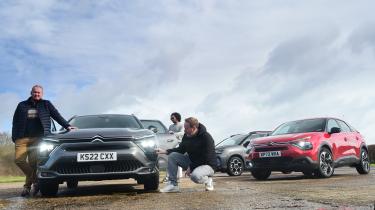
Design, interior and tech
A huge part of the way drivers and passengers experience cars is the design and technology in the vehicle. Our reviews pay close attention to these factors.
Design
It’s all well and good having a car that looks pretty on the outside, but as you'll be spending a lot of your time sitting inside, the cabin’s design is just as important. As such, we’ll focus on how well a car’s cabin is from an ergonomic point of view; how logically the interior is laid out, the positioning of the switchgear, and also how many buttons remain physical controls and how many have been confined to a touchscreen.
Aesthetics are purely a subjective thing, so a car’s design will have little influence on our overall score here, though if we feel that any original or interesting design features have been incorporated into the car’s look, we’ll point out our highlights.
Quality
The use of plush materials can have a bearing on how expensive a car feels inside, but so does how fundamentally well-screwed together the various panels and trim pieces are. Some cars can have lots of soft touch plastics and fabric coverings that give a high level of perceived quality, but may feel a little flimsy, suggesting a poorer build quality. Some cars offer the opposite, the best cars manage to do both and the worst struggle to deliver either.
Many manufacturers now offer sustainable trim materials including imitation leather. In the past, this would have been considered the cheaper alternative to real leather, but in recent years this ‘vegan’ leather option is spun as a positive thing along with other recycled or environmentally-friendly materials.
Infotainment and connectivity
Innovations in the automotive world continue to be introduced at a staggering pace, and the world of in-car tech is one of the most fiercely competed battlegrounds.
Infotainment systems play an ever-growing part of a new car’s inferior usability - literally, in some cases with screens often occupying a significant portion of a car’s dashboard. But a large display isn’t always a functional one.
That’s why we delve into the systems in great detail; we plot navigation addresses to find out how quickly it can load routes; we note the size and position of on-screen keys; the consistency in menu layouts, fonts and graphics.
Given how central a smartphone is to everyone’s modern life, we’ll pair up our own devices to note how smoothly that process goes. Many systems allow the likes of Android Auto and Apple CarPlay to connect wirelessly. While most people will only make this connection once, we’ll still pass comment on how easy the initial connection is, but also how the software operates on the proprietary display; does it obstruct built-in functions like climate control? How neatly does it fill the screen? And how reliable is the connection once it’s running?
Many manufacturers team up with well-known hi-fi brands to offer buyers high quality sound systems, but the difference in quality between some of these big names can be stark. We’ll test these setups not only when the car is stationary, but on the move, to discover how much factors like tyre roar and wind noise can affect the overall stereo performance.
If a car has any other interesting, novel or just luxurious creature comforts - whether it’s ventilated seats, a huge panoramic sunroof or fold-down cinema screens for back seat occupants, we’ll cover off all of the most exciting tech here.
Practicality
How much car buyers value practicality - specifically interior and boot space - can vary wildly based on the type of car. A survey by Auto Express revealed that estate car buyers consider it more important than any other quality in a car, while MPV buyers consider it of equal importance to value for money and reliability. Perhaps unsurprisingly, convertible buyers see it ranking much lower down their list of their priorities.
Driving position
When testing a car’s practicality we start up front, with how easy it is for the driver to get find a comfortable position at the wheel. It’s not just a wide range of adjustment in the seats and the steering wheel that helps drivers of various body types to get comfortable, but how well the steering wheel and pedals align with the seat itself can have a huge influence over a car’s long distance comfort. Seat padding, side support and the position of the headrests - whether fixed or adjustable - all matter here, too.
Having places to store smaller items can benefit practicality focused cars, so we’ll rate the size of gloveboxes, door bins and any other cubby spaces while we’re sitting up front, too.

Rear passenger space measurements
Hopping into the back seats, we take four measurements - all in millimetres. In order to measure knee room, we start from the base of the back seat and run the measure up into the back of the driver’s seat. We take two measurements here; one with the driver’s seat rolled all the way forward and another with it rolled all the way back.
Headroom is measured by working up from the base of the seat, following the angle of the backrest until it reaches the ceiling; here we note if panoramic sunroofs and the angle of the rear window intrudes on the overall distance.
Finally, we take a measurement of elbow room, which runs from the widest point of the door cutout above the armrests across to the opposite side of the cabin. If a car has three rows of seats, we'll repeat these measurements in the back.
But beyond these accurate measurements, we’ll also comment on subjective comfort and space. How supportive the seats feel is something that we’ll always note, but some smaller details can have a profound influence, too.
Some cars might have a high floor or a hump in the middle, with each potentially reducing under-thigh support and foot room. The middle seat, where there is one, can often feel like an afterthought, with less padding and a perched position compared to those places either side. In other cars, it might be almost as shapely and supportive as the outer positions. Along with the storage.
Boot space measurements
Regardless of the body style, it’s important to note how much stuff a car can handle - even drop-top buyers will look out for a boot large enough to handle a weekend away for two.
That’s why we get the tape measure out on every new car we subject to a road test, taking detailed measurements of the boot length, width (at its narrowest point) and load lip height. We’ll note if there is any underfloor storage, storage hooks or side partitions to hold smaller items in place, and in larger estates and SUVs, levers or switches mounted in the boot area that can remotely drop the rear seat backs can be a very useful feature.
In seven-seaters, we’ll note how easy (or difficult) it is to get into the back row via the side doors, and how spacious and well appointed it is once settled in.
Reliability and safety
The average member of the general public has enough on their mind without having to worry about whether or not their car is going to let them down, so dependability is hugely important - our research shows that buyers at the smaller, more affordable end of the car market value reliability higher than all else.
Thanks to the exclusive research that Auto Express carries out every year for our Driver Power customer satisfaction survey, we have access to a vast range of data that shows us not only how likely a car is to spring a fault in the first couple of years of ownership, but also how satisfying a car can be to live with - based on the feedback of owners who live with these vehicles every day.
In the event that something does go awry, manufacturers offer warranties to cover issues. Some brands offer significantly more comprehensive packages than others, so we’ll give extra marks to those who offer six, seven or even 10-year warranties over those who offer the more standard three-year packages.
Likewise, many manufacturers throw-in complementary breakdown cover, but time periods vary for these, too. Service intervals can play a part in running costs, and if manufacturers offer any sort of offers or service plans, we’ll let you know.
Finally, we’ll look at safety. The majority of new cars on sale are crash tested by Euro NCAP, giving intricate data on how well a car’s occupants can be protected in the event of an accident. Driver assistance tech aims to prevent some incidents from happening at all, and Euro NCAP notes how effective these systems are.
While we certainly try to do all we can to avoid accidents while testing vehicles, our experience of testing every new car on sale makes us superbly placed to assess which driver assist systems are the best - and the worst.
Does a lane keep system tug clumsily at the wheel to keep the car from straying onto the wrong side of the road, or is it more gentle and sophisticated? Do the speed limit warning systems accurately pick up signs? Are there so many bongs and buzzes that it’s hard to work out which noise is warning about which problem? We take this all into consideration in our reviews.

Testers notes
There might be little things that our test team has picked up on. They might be little quirks which only present themselves during our thorough road testing programme; the sort of things that won’t be picked up during a brief look around a car.
As we’ve buried ourselves deep within all of the new car press packs - and have frequently spoken to the designers, engineers and executives responsible, we’ll often share that unique insight with you in order to help you understand a car in even more intimate detail. You’ll see our testers notes as quotes from specific team members across our reviews.
What do Auto Express star ratings mean?
Each of the review categories - and some of the subcategories, are scored out of five - down to one decimal point. Not all of these categories hold the same weight for each type of car; a practicality score out of five doesn’t hold as much value when deciding our overall mark as a driving experience score for a sports car, for example.
We take all of these marks into account when the road test team establishes an overall star rating for a car. We award the overall ratings in half-star increments to give a more accurate picture to the reader of a car’s ability.
As cars age and new, better models are launched, star ratings can change. The ratings indicate where the car sits in relation to other similar models currently available on the new car market. Here’s a rundown of what our star ratings mean.
1 Star
2 Stars
3 Stars
4 Stars
5 Stars
Re-evaluating our scores
Of course, the score that we award when we first test a car isn’t set in stone. There are several things that can influence a star rating over time; most obviously when a new rival is released. Perhaps the newcomer shakes up the segment and sets a whole new standard; maybe it instead cements our existing favourite's position at the head of the class.
Prices can change (for better or for worse) over time, and updates from improved equipment levels to revised powertrains can warrant a change in score. Regardless of the reasons, we’ll gladly revisit old marks and revise our initial assessments based on new information.
Our new car road test team
- Chief reviewer: Alex Ingram
- Senior testeditor: Dean Gibson
- Online reviews editor: Max Adams

